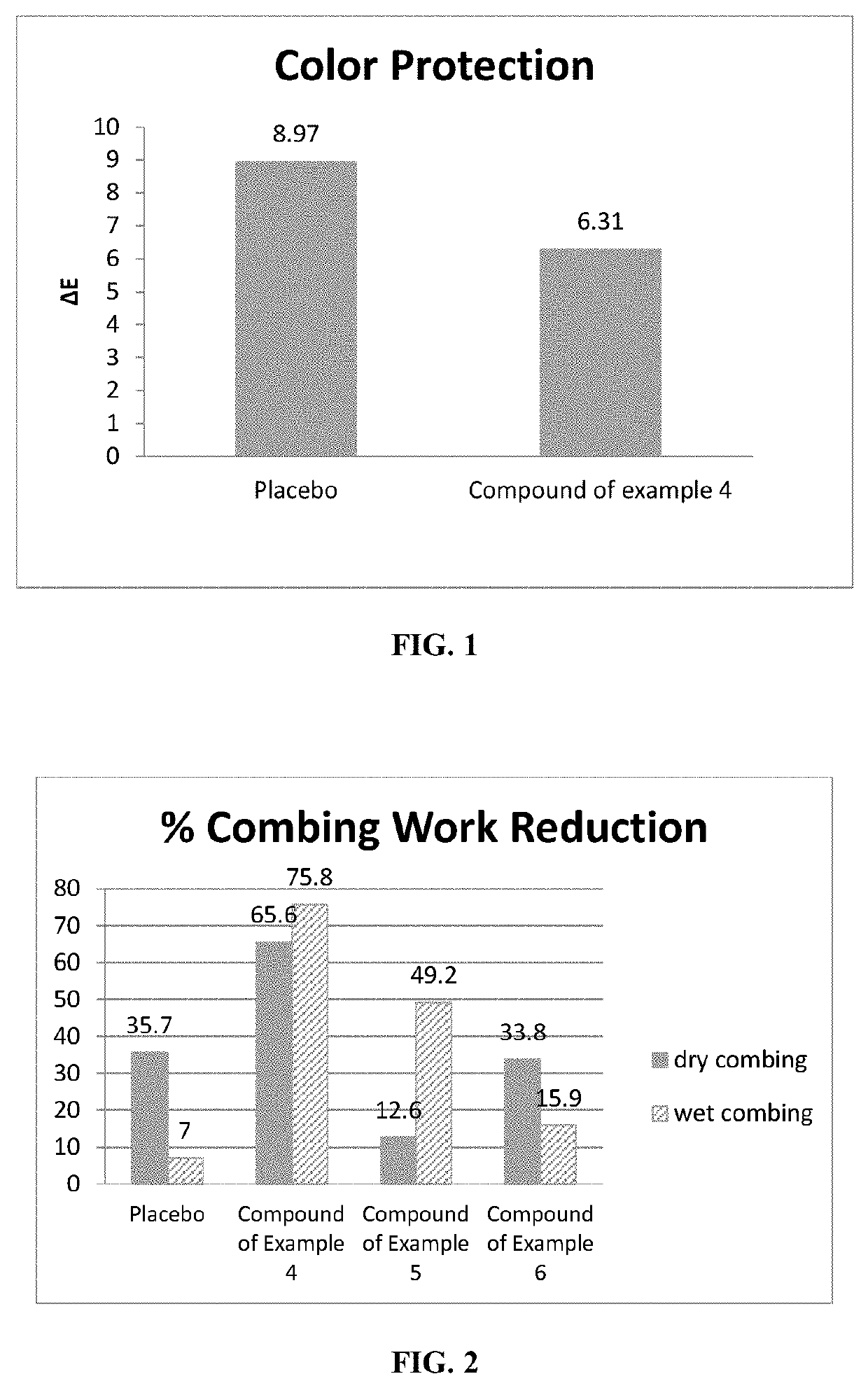Highly substantive water-soluble UV absorbers and process for preparation thereof
a water-soluble uv absorber and water-soluble technology, applied in the field of high-substantial quaternized water-soluble uv absorbers, can solve the problems of water-soluble uv absorbers that are not allowed/permissible to use, get washed away easily in rinse-off formulations, etc., and achieve the effect of reducing combing for
- Summary
- Abstract
- Description
- Claims
- Application Information
AI Technical Summary
Benefits of technology
Problems solved by technology
Method used
Image
Examples
example 1
[0075]Synthesis of p-methoxycinnamido propyldimethylamine: To a stirred solution of N,N-dimethyl aminopropylamine (55.7 g 0.55 gmol) in water (35 mL) at room temperature, under nitrogen blanket, molten p-methoxy cinnamoyl chloride (103 g, 0.52 gmol) was slowly added while maintaining the temperature between 50 to 55° C. over the period of 1 h. The stirring was continued for additional two hours. At this stage, water (20 mL) was added and the reaction mixture was cooled to 10° C. and acidified with concentrated hydrochloric acid to pH of 2. The hydrochloride salt solution was filtered and the filtrate was basified using sodium hydroxide (45% solution) to the pH of 11. The precipitated p-methoxy cinnamidopropyl dimethyl amine was filtered, washed with water and dried under vacuum at 40° C. to yield the p-methoxycinnamido propyldimethylamine (amidoamine) (121.0 g, 89%) as pale yellow colored solid (mp 92° C.).
[0076]Molar extinction coefficient, ∈, in methanol is 24,224 at 290 nm.
[0077]...
example 2
Synthesis of p-methoxy cinnamidopropyl (2-hydroxypropyl trimethyl ammonium chloride) dimonium chloride: Reaction of p-methoxy cinnamido propyl dimethyl amine and 3-chloro-2-hydroxy propyl trimethyl ammonium chloride
[0080]A mixture of p-methoxy cinnamido propyl dimethyl amine (25 g, 0.095 gmol), 3-chloro-2-hydroxypropyl trimethyl ammonium chloride (27 g, 0.095 gmol, commercially available as 65% solution) and water (33 mL) under nitrogen was stirred at 85° C. for 6 hours. The progress of the reaction was monitored by the increase in the chloride ion content. The reaction was stopped when the amidoamine content is brought to less than 1.0%.
[0081]The quaternized product, p-methoxy cinnamidopropyl (2-hydroxypropyl trimethyl ammonium chloride) dimonium chloride was obtained as pale yellow colored aqueous solution with the following analysis.
[0082]Appearance: Pale yellow colored clear liquid, pH of 5% solution: 6.8, solids content=51%, free amidoamine content=0.45%, chloride ion content=7...
example 3
Synthesis of p-methoxy cinnamidopropyl (2-hydroxypropyl lauryl dimethyl ammonium chloride) dimonium chloride: Reaction of p-methoxy cinnamido propyl dimethyl amine and 3-chloro-2-hydroxy propyl lauryl dimethyl ammonium chloride
[0085]A mixture of p-methoxy cinnamido propyl dimethyl amine (25 g, 0.095 gmol), 3-chloro-2-hydroxypropyl lauryl dimethyl ammonium chloride (81 g, 0.095 gmol, commercially available as 40% solution) and water (8.7 mL) under nitrogen was stirred at 85° C. for 6 hours. The progress of the reaction was monitored by the increase in the chloride ion content. The reaction was stopped when the amidoamine content is brought to less than 1.0%. The quaternized product, p-methoxy cinnamidopropyl (2-hydroxypropyl lauryl dimethyl ammonium chloride) dimonium chloride was obtained as pale yellow colored aqueous solution with the following analysis
[0086]Appearance: Pale yellow colored clear liquid, pH of 5% solution: 6.8, solids content=51%, free amidoamine content=0.5%, chlo...
PUM
| Property | Measurement | Unit |
|---|---|---|
| Zeta potential | aaaaa | aaaaa |
| zeta potential | aaaaa | aaaaa |
| molecular weight | aaaaa | aaaaa |
Abstract
Description
Claims
Application Information
 Login to View More
Login to View More - R&D
- Intellectual Property
- Life Sciences
- Materials
- Tech Scout
- Unparalleled Data Quality
- Higher Quality Content
- 60% Fewer Hallucinations
Browse by: Latest US Patents, China's latest patents, Technical Efficacy Thesaurus, Application Domain, Technology Topic, Popular Technical Reports.
© 2025 PatSnap. All rights reserved.Legal|Privacy policy|Modern Slavery Act Transparency Statement|Sitemap|About US| Contact US: help@patsnap.com



